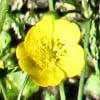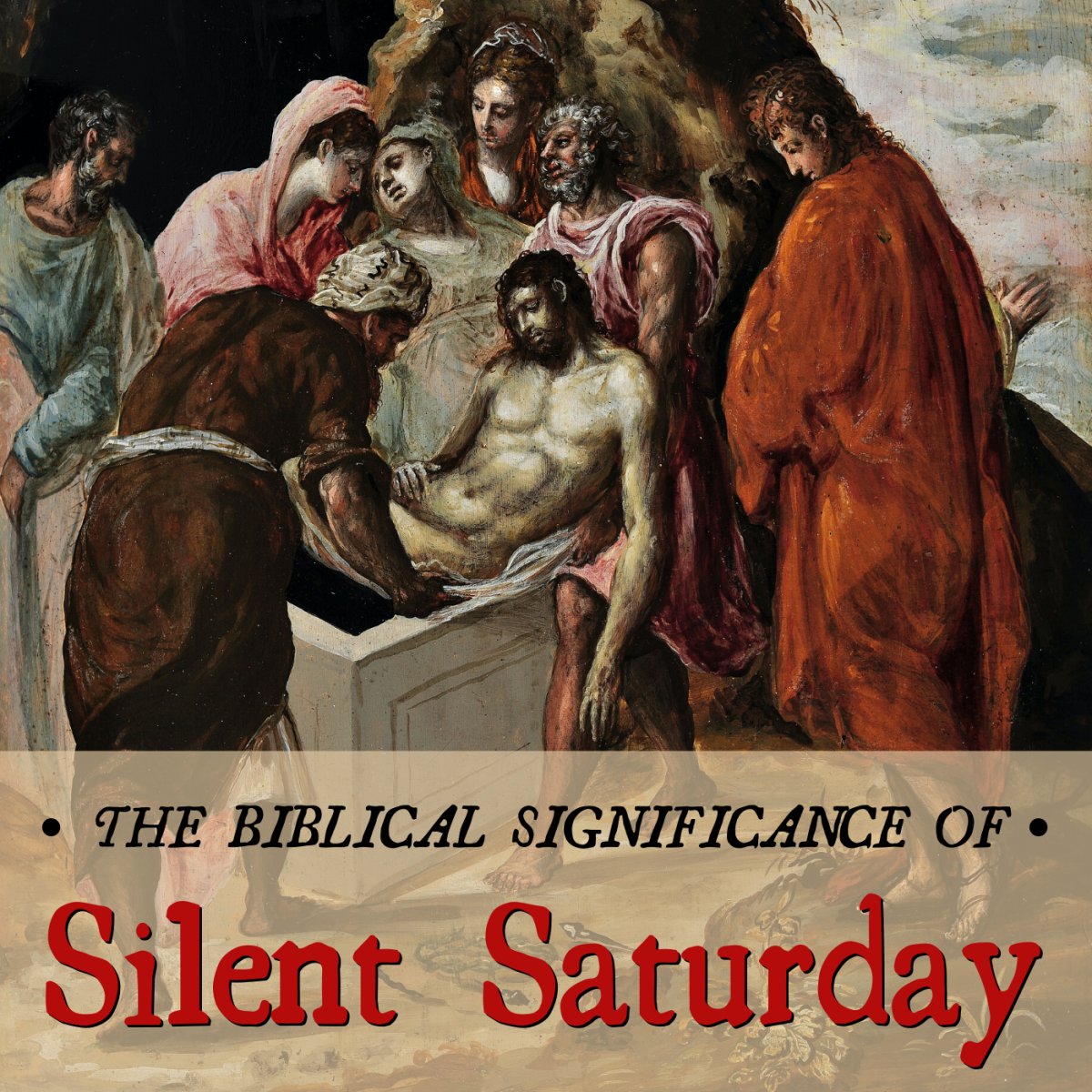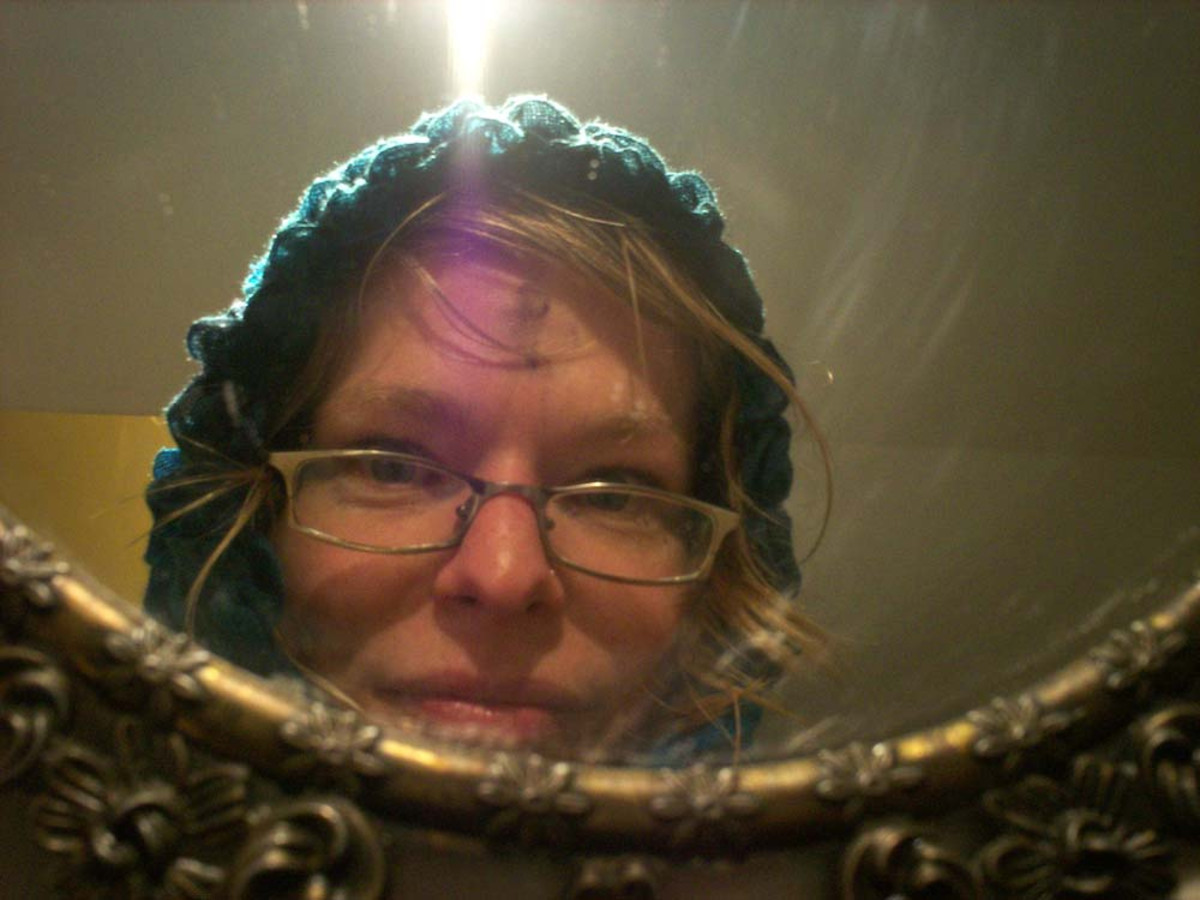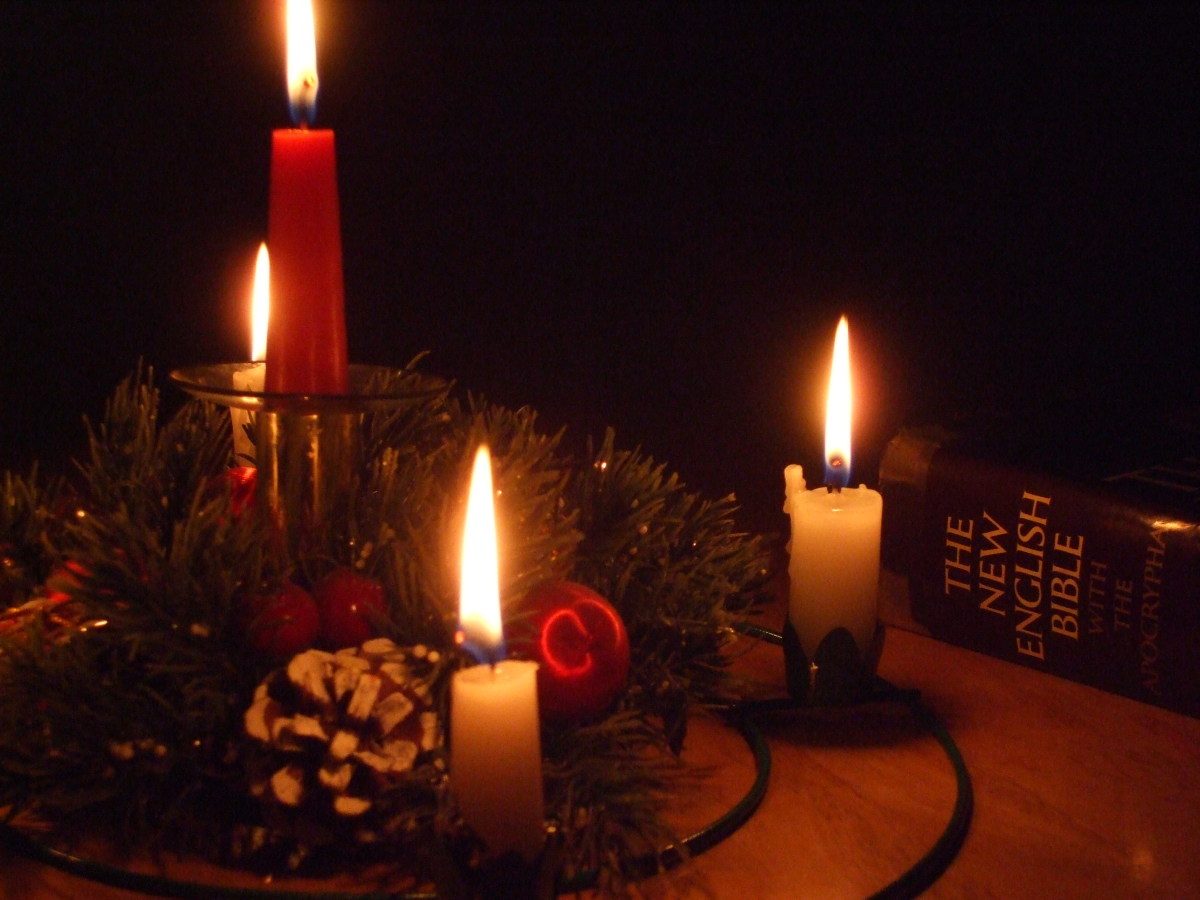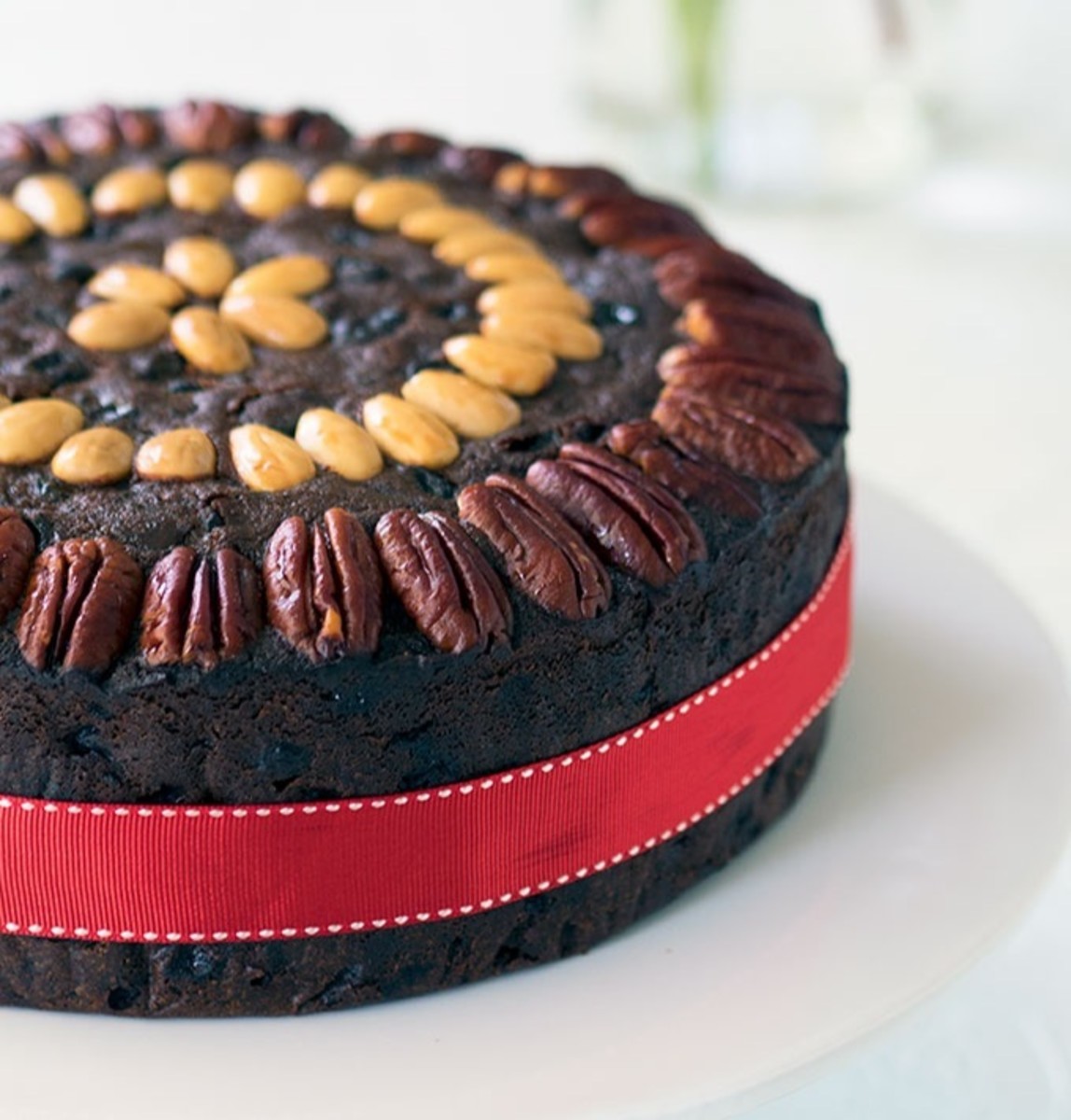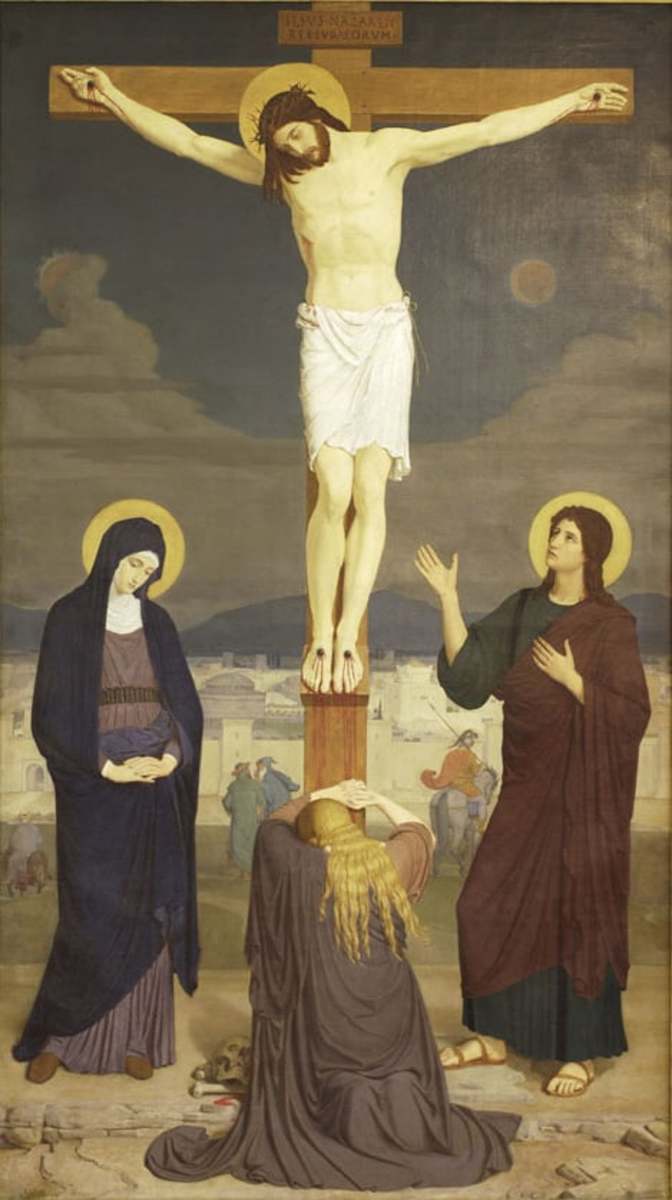An Easter Miscellany (Holy Week / Springtime)
The Truth Behind Easter
Without the Christian belief in the Resurrection of Jesus Christ, it seems unlikely that Christianity would be what it is today, which is why, for many believers, Easter is the most important day in the Christian calendar.
Certainly, Easter has been affected by commercialism. In the Northern Spring, the shops are full of boxed eggs, chocolate bunnies and pretty cards. No doubt many people might think that we are losing the ‘true’ meaning of Easter. But what actually is the truth behind Easter?
*
Copyright Tricia Mason / Trish_M. All Rights Reserved.

Easter Eggs - Happy Easter!

Why Eggs at Easter?
~ Because they symbolise new life ~ rebirth?
~ Because they were somehow linked to the Spring Goddess Eostre?
~ Because they represent the tomb of Jesus?
~ Because eggs were given up for Lent, but the hens kept laying, so there was a glut of them by Easter ~ all ready to decorate and eat (and coincidentally symbolising 'new life')?
Easter Books for Children
Resurrection Links
- The Resurrection
The Resurrection - does it make sense at all? - Resurrection of Jesus - Wikipedia, the free encyclopedia
The Resurrection of Jesus

An Easter Hymn: 'Christ the Lord Is Risen Today'
'Christ the Lord Is Risen Today '
Here is the first of the six verses:
Christ the Lord is ris'n today,
Alleluia!
Sons of men and angels say,
Alleluia!
Raise your joys and triumphs high,
Alleluia!
Sing, ye heav'ns, and earth reply,
Alleluia!
* * * *
This words of this rousing hymn were mostly written by Charles Wesley (1707-1788), brother of John Wesley (1703 – 1791), the founder of Methodism.
This is one of several hundred hymns penned by Charles Wesley, but it is not entirely original; it is based upon a 14th century Latin hymn, 'Jesus Christ Is Risen Today', which had been translated into English and published, in 1708, in the 'Lyria Davidica'.
* * * *
Here is the first verse of 'Jesus Christ Is Risen Today'
Jesus Christ is risen today,
Alleluia!
Our triumphant holy day,
Alleluia!
Who did once, upon the cross,
Alleluia!
Suffer to redeem our loss,
Alleluia!
Another version:
Jesus Christ is ris'n today!
Alleluia!
Sinners wipe your tears away!
Alleluia!
Jesus' death upon the cross
Alleluia!
Saveth us from endless loss.
Alleluia!
A Few Questions:
Where does the word 'Easter' come from?
What is the Biblical story of Easter?
What are the days of Holy week?
Why is Palm Sunday so called?
What does 'Maundy' mean in ‘Maundy Thursday’?
What is or was so 'good' about ‘Good Friday’?
Is it a coincidence that Saint Mary's Day sometimes falls in Holy Week?
Is it coincidental that Easter occurs in spring in the northern hemisphere?
Why does the date of Easter change from year to year?
Why is Easter celebrated on different dates in different countries?
Why do we have eggs at Easter and why chocolate eggs?
Why bunnies?
Why is it called 'Paques' in French?
Easter Parade

The Last Supper
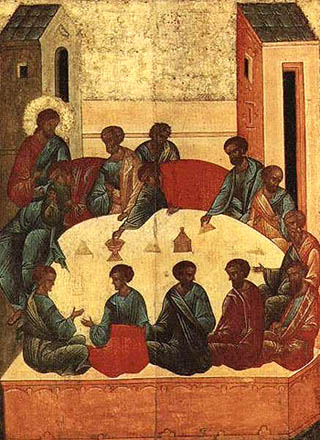
The First 'Easter'
An Easter Hymn: 'There is a Green Hill Far Away'
'There is a green hill far away'
1. There is a green hill far away
Without a city wall,
Where the dear Lord was crucified,
Who died to save us all.
2. We may not know, we cannot tell,
What pains He had to bear;
But we believe it was for us
He hung and suffered there.
3. He died that we might be forgiv'n,
He died to make us good,
That we might go at last to heav'n
Saved by His precious blood.
4. There was no other good enough
To pay the price of sin.
He only could unlock the gate
Of heav'n, and let us in.
5. O, dearly, dearly has He loved,
And we must love Him too,
And trust in His redeeming blood,
And try His works to do.
AMEN.
'Lyrics from Service Book and Hymnal: for Evening Prayer and Sunday-Schools, 1891 (no. 76)'
Alternative first verse:
There is a green hill far away,
outside a city wall,
where our dear Lord was crucified
who died to save us all.
* * * * * * * * *
The words to this lovely Easter hymn were written in 1847, by an Irish woman, named Cecil Frances Alexander (1818-1895), wife of William Alexander, Anglican primate for Ireland.
Whenever she went into the town of Derry, Ireland, she would notice a green knoll, just outside the town walls. Each time she saw it, she was reminded of Calvary, and, one night, while she was sitting up, caring for her sick daughter, she was inspired to write this hymn.
She published it in 1848 in 'Hymns for Little Children'. It is usually sung to the tune 'Green Hill', composed in 1878, by the American music writer, George C Stebbins (1846-1945).
Mrs Alexander wrote a number of hymns, including the ever-popular 'All things bright and beautiful' and 'Once in royal David’s city'.
* * * * * * * *
The Titanic
On Easter Sunday, April 7th 1912, the Titanic had been berthed at Southampton. The following Sunday evening, 14th April, Christian services took place at sea. The Reverend Ernest Carter led the hymn-singing for the second class passengers in their dining saloon, saying 'it is the first time that there have been hymns sung on this boat on a Sunday evening, but we trust and pray it won't be the last' . One of the hymns chosen was 'There is a green hill far away'. Later that night, a little before midnight, the 'unsinkable' Titanic sank.
What is the Biblical Story of Easter?
The story of the first Easter as learned from the 'New Testament' Book of Matthew.
Other accounts differ slightly.
It was nearing the time of Passover, when Jesus and his disciples arrived at the Mount of Olives, outside Jerusalem. He sent two followers to fetch him an ass with her colt. They helped Jesus onto it and he rode into Jerusalem, accompanied by a crowd, waving palm leaves, with which they strewed the path, and crying Hosanna! The people of the city asked what was happening. The multitude said that the prophet, Jesus of Nazareth, was here.
Jesus went to Jerusalem's temple, and became angry when he saw people selling doves and changing money. He upturned the tables, saying that the temple was a house of prayer, not a den for thieves. Then he healed blind and lame people, who had come to see him. The high priests and officials were very concerned at Jesus's behaviour and at the strength of his following.
Jesus left the temple and went to the Mount of Olives, where he told the disciples that the temple would be destroyed. They asked him what would happen. Jesus told them that there would be wars, famine and chaos, but, eventually, they would 'see the Son of man coming in the clouds of heaven with power and great glory'. He spoke to them in parables and finally said that the feast of the Passover was two days off and that he would be betrayed on that day.
Meanwhile, the priests and elders of Jerusalem held a meeting at the chief priest's palace, where they decided to arrest Jesus ~ but quietly, because they didn't want to stir up unrest amongst his followers. One of the disciples, Judas, offered to betray Jesus, if he was paid 30 pieces of silver.
Since Passover was near, Jesus arranged the meal that he would share with his disciples It was to be at a house in the city. In the evening, Jesus and the disciples sat down together to eat. While they were eating Jesus announced that one of them would betray him. They each asked if it would be him and Jesus indicated that Judas was the betrayer
Jesus then broke some bread and told them that this was his body and he took some wine and said that this was his blood. They sang a hymn and went back to the Mount of Olives, where Jesus told Peter that he would betray him three times before the cock crowed. Peter disagreed.
They went into Gethsemene, where the disciples sat and waited ~ and slept ~ while Jesus prayed. Jesus was desperately sorrowful and he fell upon his face and prayed that he would not have to go through with whatever awaited him, even though he was willing to do God's will. Three times he made the same prayer, and each time he was disappointed that his disciples slept in his time of distress ~ when his spirit was willing, but his flesh was weak.
After he had prayed for the third time he announced that he had been betrayed and that the betrayer was nearby. Judas ~ accompanied by an armed crowd; the same crowd which had recently cheered Jesus ~ then came over to Jesus and kissed him. This was the sign that his accusers were watching for and Jesus was arrested and taken to the elders and high priest. Peter followed at a discreet distance.
Jesus was interrogated about his behaviour at the temple and about claiming to be the son of God. He was accused of blasphemy and sentenced to death. He was pushed, hit and spat at. Peter was sitting outside the room. Some people noticed him and asked if he was a follower of Jesus. He denied it ~ three times. Then the cock crowed and Peter wept when he remembered Jesus's words.
After daybreak, Jesus was bound and taken to the Governor, Pontius Pilate, for execution. Judas felt so guilty that he handed back his silver and killed himself.
Jesus was then questioned by Pilate.
Because it was the time of Passover, Pilate was willing to free one of his prisoners ~ it could be Jesus, or a criminal named Barrabas. The crowd chose Barrabas. When Pilate asked what to do about Jesus, known as the Christ, they said 'Let him be crucified'. Pilate felt that he had done nothing to deserve execition, but it was out of his hands and Jesus was sent for crucifixion.
First, though, a scarlet robe was draped around him, a reed was put into his right hand and a 'crown', made of thorny branches, was placed upon his head. They bowed to him, mocked him, stripped him, spat at him, hit him with the reed and took him to be killed at a place called Golgotha. He was given vinegar and gall, his clothes were shared out, and the mockery continued. A sign stating 'Jesus King of the Jews' was erected above his head and people suggested that, since he was the son of God, he should be able to save himself.
About three hours after sunset, Jesus called out "My God, my God, why hast thou forsaken me?" and, shortly afterwards, as his mother, his friends and his relatives watched from a distance, he died. According to Luke 23, Jesus cried out "Father, into thy hands I commend my spirit".
At that moment, there was a great earthquake ~ the temple was affected, graves flew open, bodies were sent forth and people became very frightened and said that this really must have been the Son of God.
That night, the body of Jesus was taken to a tomb belonging to a disciple named Joseph, from Arimathea. A boulder was rolled in front of it and Mary Magdalene sat nearby with Mary, the mother of Jesus.
The next say, the Chief priests told Pilate that they wanted the tomb made secure, so that the disciples could not take the body and pretend that Jesus had risen from the dead. This was done and a watch was kept over it.
It was as the Sabbath ended, as the first day of the new week dawned, that the two Marys returned to the tomb. There appeared to be another earthquake, and an angel appeared. He told them not to seek Jesus amongst the dead, because he was now risen, and would meet them on the way to Galilee. Soon, they met up with him and they worshipped at his feet. He told them not to be afraid and to inform the disciples that he would see them in Galilee.
When the Chief priests discovered that Jesus was gone, the guards were bribed to say that the disciples had stolen the body during the night. Meanwhile, Jesus and his disciples met up in Galilee.

Spring Flowers and New Laid Eggs

Origins of the Word 'Easter'
Easter
According to the online Oxford dictionary, this word has its origins in Old English, and is related to the term 'East'.
The online etymological dictionary gives the Old English word as 'Eastre' (also 'Eostre'), which appears to derive from Germanic 'austra' and 'Austron'.
It has been deduced that this would have evolved from a proto-Indo-European language term 'aus'. The meaning would have related to shining ~ particularly of the dawn, so would have involved the sun rising in the East.
'Austron' was, apparently, the Germanic goddess of the dawn and the light and all things connected. The Spring equinox was the time when the hours of daylight began to outnumber the hours of darkness. Thus, Austron's power would have been seen to be coming into its own. It was springtime; the time of fertility and new birth ~ or rebirth. Baby animals were born; flowers began to bloom.
'Ostara' is another version of the name ~ and there are others which may be related. It could also be related to 'Aurora' ~ (goddess of) the dawn. There may even be connections to 'Ishtar', Queen of Heaven, and 'Istha' / 'Astarte', Mother Nature.
According to the Venerable Bede, (672-735), Easter was named after the Anglo-Saxon goddess Eostre / Eastre and it was their term for springtime. There is some doubt over this, as his reference to 'Eostur-monath' (April) is the only one on record, but 'Eastre' is similar to 'Austron', both are said to be a goddess of the spring and the Anglo-Saxons were a Germanic people.
"Eosturmonath has a name which is now translated "Paschal month", and which was once called after a goddess of theirs named Eostre, in whose honour feasts were celebrated in that month. Now they designate that Paschal season by her name"
According to legend, Eostre was often accompanied by hares or rabbits and was also associated with eggs. Certainly rabbits and eggs could be considered signs of fertility ~ related to spring-time and birth / rebirth.
Since Spring is a time of 're-birth' ~ or 'resurrection' ~ one has to wonder if there might be a connection between the Biblical story of the Resurrection of Jesus, and the fact that Easter occurs in Springtime in the northern hemisphere.
www.AskOxford.com
http://www.etymonline.com
http://www.religioustolerance.org/easter1.htm
http://www.fact-index.com/e/eo/eostre.html

'Passover' and 'Easter'
Origins of 'Paschal' and 'Passover'
Passover
According to the Online Etymology Dictionary, the English term 'Passover' was coined by William Tyndale**, who completed his translation of the much of the Bible, into English, in 1530. Prior to that, for many years, an equivalent of the word 'pascha' or 'paschalis' has been used in English, without translation. So, until then, the word 'Passover' probably did not exist at all. Tyndale's bible was also the first to contain the word 'Easter' ~ but that word was not his own invention.
The word was used to translate the Hebrew term 'Pesah' or 'Pesach', which could be translated as 'to pass over. I have also read that 'Pesach' could be translated as 'to hover over', with the meaning of protecting or watching over.
'Pesach' was known as 'pasha' in Aramaic, 'pascha' in Greek and 'paschalis' in Latin. In Middle English, the word 'Pasche' was used for 'Easter'. This is, effectively, the same word as is currently used in many other languages ~ eg French: 'Paques', where, according to my reading, the word is used for both 'Easter' and 'Passover'.
In 1382, John Wycliffe translated Acts 12:4 thus:
'And whanne he hadde cauyte Petre, he sente hym in to prisoun; and bitook to foure quaternyouns of knyytis, to kepe hym, and wolde aftir pask bringe hym forth to the puple.'
Compare this verse in the New International Version:
'After arresting him, he put him in prison, handing him over to be guarded by four squads of four soldiers each. Herod intended to bring him out for public trial after the Passover.'
Much earlier, the venerable Bede, who lived from 672 to 735 claimed that the month of April had once been named 'Eostur-monath', after a Germanic goddess, but was now known as 'Paschal month'.
The paschal full moon provides the date for 'Passover'. It is the first full moon after (or on) the Spring / Vernal equinox.
The First 'Passover'
The story of the first 'Passover' is told in the book of Exodus (Old
Testament / Hebrew Scriptures).
Exodus 12
The
LORD spoke to Moses and Aaron in Egypt saying, This month shall be the
beginning of months: the first month of the year to you.
Speak to
all the congregation of Israel, saying, On the tenth day of this month
every household shall take a lamb, keep it until the fourteenth day of
the month: and the whole assembly of the congregation of Israel shall
kill it in the evening and take the blood, and strike it on the two side
posts and on the upper door post of the houses, wherein they shall eat
it.
They shall eat the flesh that night, roast with fire, with
unleavened bread and bitter herbs.Any parts which remain until morning
you shall burn. Eat it with your loins girded, your shoes on your feet,
and your staff in your hand; and eat it in haste: it is the LORD's
passover.
I will pass through the land of Egypt this night, and
will smite all the firstborn in the land of Egypt, both man and
beast.... I am the LORD.
The lamb's blood shall be a token upon
the houses where you are. When I see the blood, I will pass over you,
and the plague shall not be upon you ... when I smite the land of Egypt.
This
day shall be for you a memorial; and you shall keep it as a feast to
the LORD throughout your generations ... for ever. For seven days you
will eat unleavened bread; whosoever eats leavened bread ... shall be
cut off from Israel.
The children of Israel did as the LORD
commanded and at midnight the LORD smote all the firstborn in Egypt ....

Tyndale** and his Bible
- The Renaissance Reformation
There is some very interesting information about Tyndale in this hub. - William Tyndale - Wikipedia, the free encyclopedia
William Tyndale - Info from Wikipedia - William Tyndale's Translation
William Tyndale's Bible online

The Date of Easter - A Movable Feast?
To calculate the date of Easter:
Find the full moon which falls on, or after, the Spring equinox (set at 21st March) ~ and Easter will be the following Sunday.
This calculation is based on the paschal full moon and the vernal equinox and the fact that the Bible indicates that Jesus was crucified the day after 'The Last Supper' and that he rose from the grave on the Sunday after this.
'Western Christendom' uses the Gregorian calendar. The Eastern church still calculates Easter according to the older, but less accurate, Julian Calendar. Eastern Orthodox Christians, therefore, celebrate Easter on a different Sunday from Western Christians.
Over the centuries, there has been a certain amount of controversy concerning the dating of Easter.

The First 'Palm Sunday'
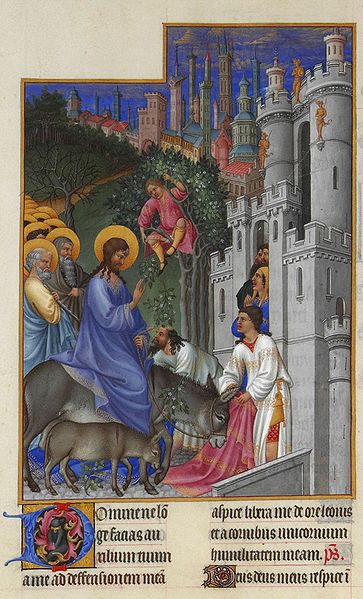
Palm

Eastertide, Lent, Holy Week, Etc
Shrove Tuesday
Shrove Tuesday immediately precedes 'Lent'(which begins with 'Ash Wednesday'). Traditionally, it was the day when Christians were 'shriven'. This involved confession and absolution of sins. It was also a feast day, when all the foods to be given up during the Lenten fast might be consumed. Hence 'Shrove Tuesday' also came to be called 'Pancake Day' or 'Mardi Gras. The Spanish 'Martes de Carnaval' probably refers to the eating of meat prior to Lent.
Mardi + Martes = Tuesday
Gras = grease or fat
Carne = meat
Ash Wednesday
Ash Wednesday is the first day of Lent and a day when Christians think upon sin and death and repentence. In some churches, a cross of ash is marked upon their foreheads.
Lent
According to the Online Etymological Dictionary, 'Lent' is short for 'Lenten' and derives from the Old English word 'lencten', meaning 'spring'. It may be related to the word 'long' and refer to the lengthening of the days in Spring.
Lent is a period of fasting and penitence, leading up to Easter. It lasts for 40 days and 40 nights, in remembrance of Jesus's time of fast in the desert.
In the Western Church it begins on Ash Wednesday ~ the day after Shrove Tuesday ~ and ends on Easter Saturday. These 40 days of fast do not include Sundays.
In the Eastern church it begins on the Monday of the seventh week before Easter and ends on the Friday that is 9 days before Easter.
Holy Week ~ the last week of Lent
Palm Sunday ~ The first day of Holy Week. The Sunday before Easter, commemorating the day that Jesus entered Jerusalem in triumph.
Holy Monday
Holy Tuesday
Holy Wednesday ~ Spy Wednesday. When Judas spied on Jesus
Holy Thursday / Maundy Thursday ~ The institution of the Eucharist. The Last Supper.
'Maundy' derives from the old French word 'mande', from the Latin 'mandatum novum', meaning ‘new commandment’. It refers to this Biblical passage:
John 13:34
"A new command I give you: Love one another. As I have loved you, so you must love one another. 35By this all men will know that you are my disciples, if you love one another."
Good Friday ~ The Crucifixion of Jesus. God's Friday or the Friday when 'good' conquers all, perhaps??
Holy Saturday / Easter Saturday ~ Jesus 'resting' in the tomb. Easter Vigil. End of Lent.
Easter Sunday ~ The Resurrection.
Eastertide
'Eastertide' stretches from Easter Sunday until Pentecost Sunday ~ a period of 50 days. (Also: 'Easter Season', 'Paschal Time')
*
Saint Mary's Day.
March 25 ~ The Annunciation or Saint Mary's Day
(usually 'moved' to avoid Holy week or certain Sundays)
Celebrates the announcement, by the angel Gabriel, to Mary, that she will become the mother of God incarnate.
The date is close to the Vernal Equinox, this being nine months before the Winter Solstice, when the birth of Jesus is celebrated.
This date ~ 'Lady Day' in England ~ was once the beginning of the 'New Year' in many countries.
Spring Daffodils

Semana Santa - 16th Century Penitent
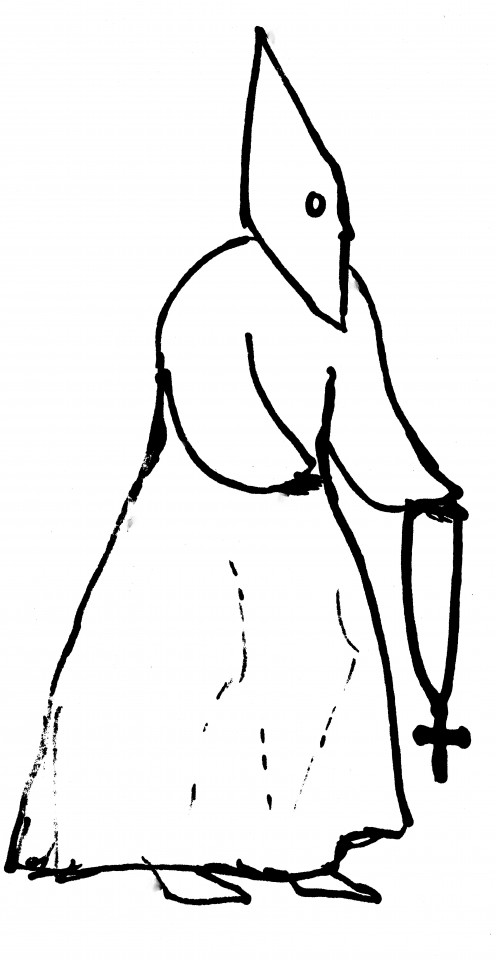
'Semana Santa' - Goya
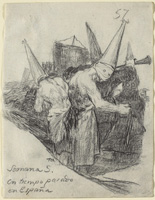
Semana Santa Procession
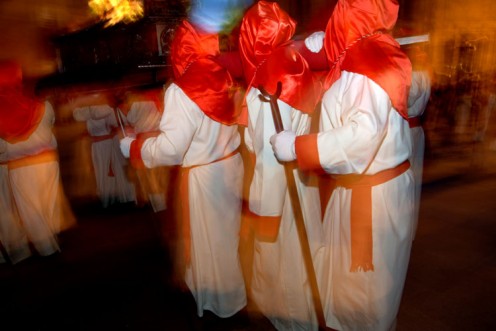
Holy Week Processions
The first Easter 'processions' could probably be described as the New Testament stories of Jesus's exultant entry into Jerusalem, accompanied by 'the multitude', and the very sad occasion, a few days later, when he walked, with his execution cross, to Calvary.
Nowadays, Palm Sunday processions occur in much of the Christian world, and, in Spain, processions are a highlight of the 'Semana Santa'. Though the 'penitents' dress in costumes reminiscent of the Ku Klux Klan, they are certainly not members of that organisation. The processions are organised by the
religious brotherhoods (hermandades and cofradías ) and the exact outfit worn by the penitents (nazarenos) depends upon the actual procession and brotherhood of which one is a member. Some brotherhoods are ancient; some are modern.
Although information on the subject is lacking, Seville can trace her 'Holy Week' activities to the second half of the 14th century. By 1578, there were already 30 brotherhoods, in that city, performing the penitential procession during Holy week.
The first known images of such a procession, dating to around the 16th century, are to be found, not in Spain itself, but in her 'American' colonies.
Susan V. Webster and the Spanish-American Processions
When, in 1995, Susan V. Webster (currently Jane Williams Mahoney Professor of Art History at William & Mary) gave a presentation on the Spanish processions of Holy Week, she included some images of the earliest-known depictions of 'Semana Santa' processions. These were not from Spain, itself, but were discovered in three churches in 'New Spain' ~ that is in Mexico ~ in the Spanish colonies of 'the Americas'.
The three sixteenth-century Mexican monasteries where the murals were found:
~ San Juan Dominican Monastery, Teticpac, Oaxaca
~ San Martín Franciscan Monastery, Huaquechula, Puebla
~ San Miguel Franciscan Monastery, Huejotzingo, Puebla
No early pictorial records of the Holy Week processions were known to exist, so, as Ms Webster commented; 'Imagine my delight ... when I first came across a series of murals representing Holy Week penitential processions in three sixteenth-century Mexican monasteries.'
The images are protected by copyright, so cannot be reproduced in this hub, but images of the murals may be seen here ~ along with other, similar, artwork:
http://www.interamericaninstitute.org/mural_art.htm
The images of the penintents, similar to those seen today, are at Huejotzingo.
Also on that page is another image of a procession, with penitents dressed in a similar manner to those who take part in Semana Santa processions today. The photograph is the property of James B. Kiracofe and the Inter-American Institute. It is from Huaquechula, Puebla and it is shown here:
http://www.interamericaninstitute.org/Huaquechula_Penitents.jpg
'Capuchones' - Penitents, Semana Santa, Valladolid

'Semana Santa' by Goya
Holy week, Procession and Penitents
- William & Mary - Directory Page Title
Susan V. Webster - Academic background

Spring Equinox - A Special Time
The Spring equinox (vernal equinox) was special long before it became important in Judaism or Christianity.
The equinoxes, like the solstices, have long held spiritual as well as 'real' importance for man.
At Knowth.com you can read about the special effects, generated by sunlight entering the 5000-year-old 'Cairn T', at Loughcrew, as the sun rises on the Equinoxes:
Gossan Stones Equinox Sunrise Alignment
http://www.knowth.com/gossan-equinox.htm
Equinox Sunrise - Loughcrew
http://www.knowth.com/images-loughcrew/cairnt.jpg
Video of Loughcrew Spring Equinox March 2005
http://www.knowth.com/loughcrew-equinox-video.htm
Equinox Sunrise Illumination - Loughcrew Cairn T
http://www.knowth.com/loughcrew-equinox.htm
Loughcrew Equinox Sunrise - March 2010
http://www.newgrange.com/loughcrew-mar10.htm
There are also some wonderful photographs, including one of the sunrise at the equinox, as it is
YouTube
http://www.youtube.com/watch?v=7yKJUFU7BXo
Faberge Kremlin Easter Egg - 1906

Fabergé and Easter Eggs
Some of the most beautiful and famous Easter Eggs in the world were the work of the 'House of Faberge' ~ originally from France, the family later settled in Russia.
Carl Fabergé was the Russian Imperial Court Jeweler. The House of Fabergé produced beautiful bejewelled eggs, works of art both large and small, between 1885 and 1917.
Their most famous patrons were the Russian royal family.
In 1906, an egg of the Kremlin was made.
Many, similar, decorative eggs have been ispired by Faberge, and there are a number of books and websites on this subject.
Faberge Eggs
Faberge Links
Easter-Related Items from HubPages:
Easter Books for Kids

